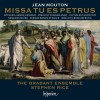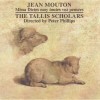| 国家: | 法国 |
| 期间: | Renaissance |
传记
Jean Mouton (c. 1459 – 30 October 1522) was a French composer of the Renaissance. He was famous both for his motets, which are among the most refined of the time, and for being the teacher of Adrian Willaert, one of the founders of the Venetian School.
He was born Jean de Hollingue either in 1459 or earlier, but records of his early life, as is so often the case with Renaissance composers, are scanty. Most likely he was from the village of Haut-Wignes (now Wirwignes), near Boulogne-sur-Mer. He probably began his first job, singer and teacher at the collegiate church in Saint Omer, then moved to Nesle (southeast of Amiens) in 1477, and in 1483 was made maître de chapelle there. Sometime around this time he became a priest, and in 1500 he was in charge of choirboys at the cathedral in Amiens. In 1501 he was in Grenoble, teaching choirboys, but he left the next year, most likely entering the service of Queen Anne of Brittany, and in 1509 he was granted a position again in Grenoble which he could hold in absentia. Mouton was now the principal composer for the French court. For the remainder of his life he was employed by the French court in one capacity or another, often writing music for state occasions—weddings, coronations, papal elections, births and deaths.
Mouton composed a motet, Christus vincit, for the election of Leo X as pope in 1513. Leo evidently liked Mouton's music, for he rewarded him with an honorary title on the occasion of a motet he composed for the pope in 1515; the pope made this award during a meeting in Bologna between the French king and the pope after the Battle of Marignano. This trip to Italy was the first, and probably only trip that Mouton made outside of France.
Sometime between 1517 and 1522 the Swiss music theorist Heinrich Glarean met Mouton, and praised him effusively; he wrote that "everyone had copies of his music." Glarean used several examples of Mouton's music in his influential treatise, the Dodecachordon.
Mouton may have been the editor of the illuminated manuscript known as the Medici Codex, one of the primary manuscript sources of the time, which was a wedding gift for Lorenzo de' Medici, who was Duke of Urbino.
It is considered to be very likely, but not proven, that Mouton was in charge of the elaborate musical festivities by the French at the meeting between François I and Henry VIII at the Field of the Cloth of Gold, based on the similarity to the similar festivities five years earlier after the Battle of Marignano.
Mouton was hugely influential both as a composer and as a teacher. Of his music, 9 Magnificat settings, 15 masses, 20 chansons, and over 100 motets survive; since he was a court composer for a king, the survival rate of his music is relatively high for the period, it being widely distributed, copied, and archived. In addition, the famous publisher Ottaviano Petrucci printed an entire volume of Mouton's masses (early in the history of music printing, most publications contained works by multiple composers).
The style of Mouton's music has superficial similarities to that of Josquin des Prez, using paired imitation, canonic techniques, and equal-voiced polyphonic writing: yet Mouton tends to write rhythmically and texturally uniform music compared to Josquin, with all the voices singing, and with relatively little textural contrast. Glarean characterized Mouton's melodic style with the phrase "his melody flows in a supple thread."
Around 1500, Mouton seems to have become more aware of chords and harmonic feeling, probably due to his encounter with Italian music. At any rate this was a period of transition between purely linear thinking in music, in which chords were incidental occurrences as a result of correct usage of intervals, and music in which the harmonic element was foremost (for example in lighter Italian forms such as the frottola, which are homophonic in texture and sometimes have frankly diatonic harmony).
Mouton was a fine musical craftsman throughout his life, highly regarded by his contemporaries and much in demand by his royal patrons. His music was reprinted and continued to attract other composers even later in the 16th century, especially two joyful Christmas motets he wrote, Noe, noe psallite noe, and Quaeramus cum pastoribus, which several later composers used as the basis for masses.








